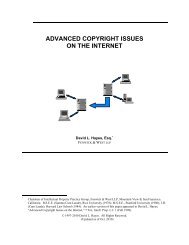International Tax Aspects of Foreign Currency Transactions
International Tax Aspects of Foreign Currency Transactions
International Tax Aspects of Foreign Currency Transactions
You also want an ePaper? Increase the reach of your titles
YUMPU automatically turns print PDFs into web optimized ePapers that Google loves.
can rebut this presumption by showing that the other transactionhedged other ordinary business risks.Example 1. <strong>Tax</strong>payer borrows in a foreign currency at a rate <strong>of</strong>3% (less than the AFR). <strong>Tax</strong>payer has no QBUs operating in thatcurrency. <strong>Tax</strong>payer enters a swap that covers most, but not all, <strong>of</strong>its currency risk on the borrowing. The net currency loss on theborrowing adjusted for the swap is allocated and apportioned in thesame manner as interest.Example 2. Same as above, except that the taxpayer borrows intwo functional currencies and enters a swap in a single currencythat reduces currency risk on both borrowings. The above ruleapplies to both loans.Reg. § 1.861-9T(b)(6) – hedges <strong>of</strong> the taxpayer’s interest bearingdebt. Financial products that alter the taxpayer’s borrowing costs,such as interest rate hedges, options, caps, collars, etc., may becontemporaneously identified as hedges. In this case, gain or losson the financial product is allocated and apportioned in the samemanner as interest. 12 Both the borrowing and the hedge must be ina single currency and the rule does not apply to the extentotherwise provided in § 988. Thus, this rule would seem to havelimited impact on currency hedging.However, in the following Chief Counsel memorandum, the IRSsuggested that this regulation or at least § 1.861-9T(b)(1) mightapply to re-source a currency loss on a hedge <strong>of</strong> a non-functionalcurrency borrowing as interest. That is, the IRS continued to applyExample 2 from the expired 1989 temporary regulations.FSA #003260 – the taxpayer borrowed € in order to effect aforeign acquisition, and entered a € : $ swap to hedge its exposure.Later, the taxpayer borrowed $ to refinance the € indebtedness. Itwas required to make a termination payment to be released from itscurrency swap. The IRS National Office interpreted 1.861-9T(b)(6) to apply to gain or loss with respect to the taxpayer’scurrency hedge, but advised that the amendments that added§ 1.861-9T(b)(6) and Example 2 <strong>of</strong> § 1.861-9T(b)(1) to theregulations had expired under the sunset rule <strong>of</strong> § 7805(e)(2).Therefore, these rules were no longer in force. However, the IRSfound that the loss on the currency swap fell within the general rule12If the taxpayer fails to identify the hedge, then loss alone is allocated and apportioned as interest, while gainremains 100% U.S. source. See Reg. § 1.861-9T(b)(6)(iv)(B); TD 8257.20© 2013 William R. Skinner, Esq.Fenwick & West LLPwrskinner@fenwick.com
















